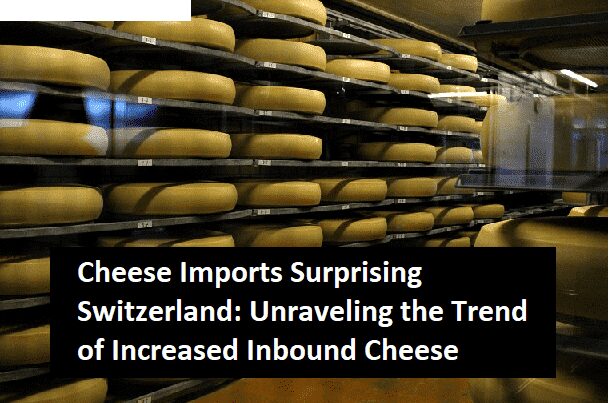Switzerland Cheese Import: Unraveling the Trend of Increased Inbound Cheese: Switzerland’s famed cheeses, including Gruyère and Emmental, are manufactured from happy Swiss cows’ milk. Swiss cheese lovers consume nearly 50 pounds each year, compared to 40 pounds in the US.
Swiss milk director Daniel Koller stressed the importance of cheese in Swiss culture. When the association’s president announced that Switzerland would import more cheese than it exports this year, it created a stir. After Switzerland liberalized its market in 2007, enabling tariff-free trade with the EU, the cheese trade balance shifted over decades.
As the Swiss acquired a liking for foreign cheeses, Swiss cheese consumption declined. Local cheese consumption dropped to 64% in 2022 from 77% in 2007.


This change is due to the decline of Swiss dairy producers. In the previous 25 years, dairy producers have lost more than half their herds, averaging 27 cows. Switzerland has few 100-cow dairy farms.
However, economists don’t worry about rising cheese imports. Swiss cheese makers now concentrate in exporting Gruyère. Imported cheesesmostly from Franceare cheaper and softer. Some imported cheese is polished in Switzerland and exported.
Martin Mosler, an economist at the University of Lucerne’s economic policy institute (IWP), doesn’t worry about cheese trade differences. Swiss cheese commerce is profitable. Swiss cheese exports cost 10 Swiss Francs per kilo ($11.60), while imports cost six.
Read Also: Mushroom Diplomacy: Janet Yellen Culinary Craze in China
Swiss cheese is likewise shaped by inflation. Due to inflation in Germany, Switzerland’s major market, Swiss cheese exports fell in 2022 after a record year in 2021. Inflation strained buyers’ wallets, affecting cheese sales in the neighboring countries.
The strong Swiss currency made cheese imports cheaper for Swiss consumers. Imports increased alternatives at reduced costs, helping Switzerland economically.
However, Swiss farmers making cheaper cheeses may suffer from the trade balance. Swiss cheese industry has suffered from rising milk costs. The number of farms is declining, following European patterns, mostly due to economic and societal causes.
Daniel Koller encourages people to buy Swiss-made cheese for the local market. Despite a rising appetite for foreign cheeses, he concedes that European Union goods typically match Swiss standards.
Switzerland’s love of cheese and commitment to quality define its culinary character, even when the cheese trade balance changes.
Also Read: Amsterdam Banning Cruise Ships to Tackle Overtourism
Our Reader’s Queries
What is the trend in the cheese market?
The cheese market is being influenced by a growing understanding of the importance of nutrients like calcium, phosphorus, zinc, vitamin A, and vitamin B12. These nutrients are crucial for bone health and building strong muscles. As a result, we’re seeing changes in the cheese industry to meet these demands for healthier options.
Why is cheese so expensive 2023?
The initial nine months of the CME cheese market in 2023 have been defined as the “Year of Overcorrection.” The increased export demand in 2022 extended into the first quarter of 2023, causing prices to remain excessively high in the US, leading to a decline in domestic demand. This overcorrection has had significant impacts on the market and will continue to influence trends in the cheese industry.
How has the production of cheese changed over time?
By the year 1900, the amount of cheese produced on farms had become very small. The 1904 census only included cheese made in factories, which was more than 317 million pounds. As the demand for cheese kept growing quickly, the production of manufactured and processed cheese also went up a lot.
Is cheese in high demand?
Data indicates that Americans have increased their cheese consumption by about half a pound compared to the previous year. Furthermore, their appetite for ice cream has also grown, but their preference for yogurt, butter, and milk has dwindled. The surge in cheese demand has propelled dairy consumption in 2022 to its second-highest level ever recorded.

